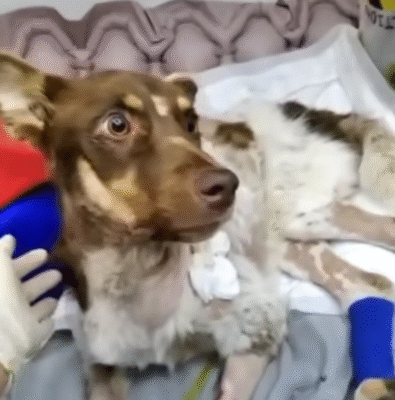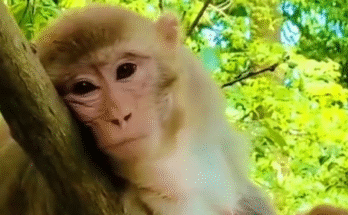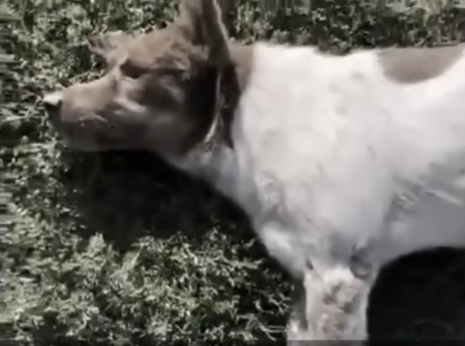
He was just a small, trembling shadow lying in the corner of the shelter cage when we first saw him. A bundle of bones, patches of missing fur, and eyes clouded into a milky white haze that told a story of long-term neglect. At first glance, he didn’t look alive—only the faint rise and fall of his ribcage hinted that there was still a flicker inside. The staff whispered that he’d been found by the roadside, collapsed from exhaustion, blind from untreated infections, and so malnourished that he barely had the strength to lift his head.
When the vet examined him, the diagnosis was brutal: “He has no chance. The kindest thing is to let him go.”
Those words echoed around us like a sentence. Maybe for some animals, it would have been the end—but something in him, in the way he tried to nuzzle our fingers despite his weakness, told us he had not given up. And because he hadn’t, we couldn’t either.
We refused to let him go.
We named him Ash—not just for his grey, soot-colored fur, but because he reminded us of the dying ember of a fire that still, miraculously, glowed. The first hours were critical. He couldn’t stand without collapsing, and his eyes were so deeply infected they leaked continuously, leaving wet trails on his face. Every breath rattled. Every whimper cut straight into our hearts. But we wrapped him gently in a warm blanket, whispering that he wasn’t alone anymore.
The first night was the longest. Ash lay in a small bed by our side, drifting in and out of consciousness. Each time he stirred, he winced as if simply existing caused him pain. We think he expected every touch to hurt—it was how he had survived, after all. But slowly, carefully, he learned that our hands meant safety, not harm. When he felt the warmth of our palms on his head, his body relaxed just enough to let out a soft, fragile sigh.
The next morning, we brought him back to the vet—not for euthanasia, but for a plan. We begged for options. We pleaded for time. The vet shook his head, warning us that dogs in Ash’s condition rarely made it through the first week. But he agreed to help us try: IV fluids to hydrate him, antibiotics for his eyes, treatment for parasites, nutritional therapy, and a delicate schedule for feeding him tiny amounts every few hours.
The road ahead was carved with uncertainty. But Ash had one thing he’d never had before: someone fighting for him.
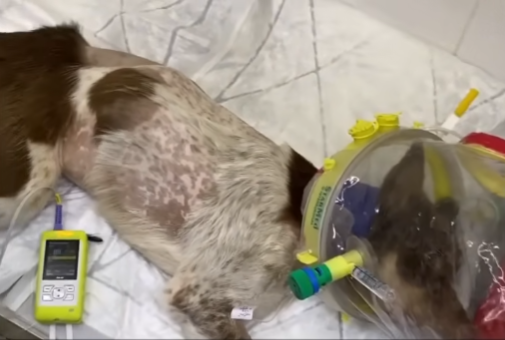
The first improvement came in the smallest form—he lifted his head without collapsing. It was just for a moment, but it was a victory that brought tears to our eyes. A few days later, he took a step, wobbling like a newborn fawn. Then, another. The illness still clung to him fiercely, but Ash had decided something: he wasn’t done living.
We documented everything, not because we wanted attention, but because his story needed to be told. People needed to see that the “hopeless” can rise again when given even the smallest chance.
By the third week, Ash transformed from a silent, skeletal creature into a dog who actually wagged his tail—slowly at first, as if he wasn’t sure he remembered how. He began responding to our voices. Though blind, he learned to navigate the house by smell and sound. We added gentle chimes to the corners of rooms to guide him. His favorite was the tiny bell beside our bed; whenever he heard us wake up, his ears perked, and he’d shuffle toward the sound to nuzzle our hands good morning.
Of all his treatments, the work on his eyes was the hardest. The infections had scarred them beyond repair—his blindness was permanent. The vet apologized, but we weren’t asking for a miracle. We were asking for him to live, to be happy, to feel loved. And he was.
One rainy afternoon, about two months after we found him, the moment that changed everything happened. Ash was lying near the window, listening to the sound of falling rain. We were cleaning his medication tray when all at once we saw him stand—stronger than ever—and trot toward us. Not wobbling. Not collapsing. Just confidently moving with the rhythm of a dog who finally trusted his legs. He stopped in front of us, lifted his face, and pressed his head gently into our chest.
He was saying thank you, in the only way he could.

The vet who once said “no chance” couldn’t believe the transformation. When Ash visited for a check-up, the staff gathered around him in disbelief. His fur had grown soft and full again. His frame, once skeletal, had filled out. And although his eyes remained cloudy, his spirit was bright—so bright that even strangers felt it when they touched him.
“He’s a miracle,” one of the technicians whispered.
But we didn’t see a miracle. We saw a life that simply needed a chance—a life that so many others would have given up on long before.
Ash now sleeps peacefully curled beside us every night. He loves the sound of our footsteps, the smell of treats, the feel of sunshine on his face. He may not see the world, but he feels it deeply. And in return, he teaches us every day about strength, resilience, and the quiet, powerful will to live.
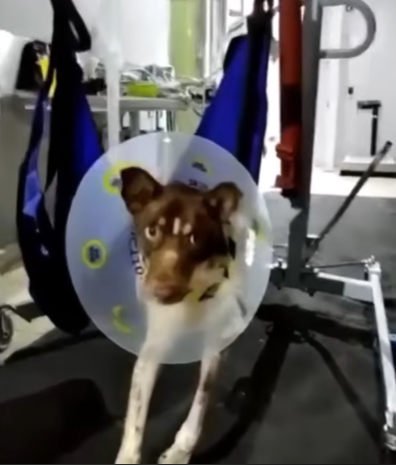
Sometimes, when we watch him exploring the yard with his nose lifted to the breeze, we remember the skeletal dog on that cold shelter floor—the one who could barely breathe, who couldn’t stand, who everyone believed was too far gone. It feels unreal that he’s the same animal. The difference wasn’t medicine alone.
It was love.
It was stubborn hope.
It was refusing to believe that a life in agony was a life not worth saving.
Ash reminds us that even when the world has given up, there is still room for compassion. There is still room to try. There is still room to fight for the ones who can’t fight for themselves.
He may have been left blind, collapsing, and betrayed by the world—but he rose again, not because his body was strong, but because his heart was. And that heart, once flickering like a dying ember, now burns warm and bright in a home where he will never be abandoned again.
The vet said “no chance.”
But Ash proved that sometimes, the smallest chance is all a soul needs to find its way back to life.
